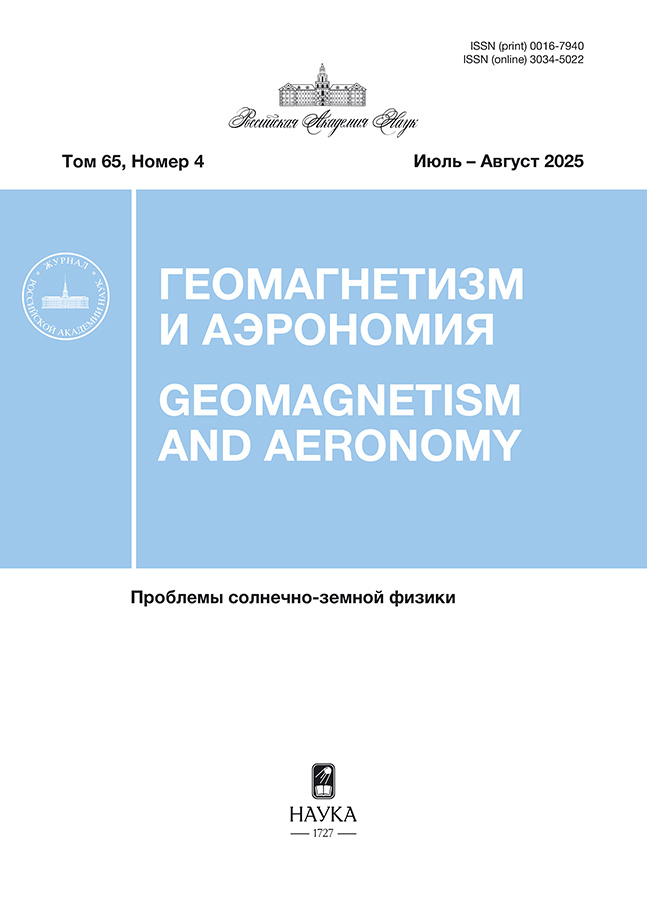Time sequence of quasiperiodic geomagnetic disturbances during substorms
- Authors: Ismagilov V.S.1, Kopytenko Y.A.1
-
Affiliations:
- Pushkov Institute of Terrestrial Magnetism, Ionosphere and Radio Wave Propagation RAS, Russian Academy of Sciences
- Issue: Vol 65, No 4 (2025)
- Pages: 448-458
- Section: Articles
- URL: https://bioethicsjournal.ru/0016-7940/article/view/688291
- DOI: https://doi.org/10.31857/S0016794025040042
- EDN: https://elibrary.ru/EXNRBA
- ID: 688291
Cite item
Abstract
Based on the data from the 2D IMAGE network and magnetic stations located in Russia, a study was conducted of a sequence of quasi-periodic geomagnetic variations with an amplitude of up to 600 nT and a duration of ~20 min that arose in the post-midnight sector during a minor global magnetic storm. It was shown that geomagnetic variations arose against the background of substorms at the same corrected geomagnetic latitude Φ′ ~65° sequentially one after another and moved by ~20° in longitude to the east, with a new variation occurring when the previous one moved by ~10°. It was shown that the ionospheric source of these variations is a pair of Hall current eddies, each of which has an elliptical shape with a major axis in the north-south direction. The estimated size of the ionospheric source is ~940 km in the west-east direction (each Hall current vortex is ~470 km) and ~1000 km in the north-south direction. The centers of the ionospheric sources of these variations moved eastward at a speed of ~0.8 km/s. It is shown that each geomagnetic variation is accompanied by a burst of Pi1–2 geomagnetic pulsations. It is suggested that the observed geomagnetic variations are created by magnetic fields of ionospheric current systems of microsubstorms.
Keywords
Full Text
About the authors
V. S. Ismagilov
Pushkov Institute of Terrestrial Magnetism, Ionosphere and Radio Wave Propagation RAS, Russian Academy of Sciences
Author for correspondence.
Email: ivs@izmiran.spb.ru
St. Petersburg Branch
Russian Federation, St. PetersburgYu. A. Kopytenko
Pushkov Institute of Terrestrial Magnetism, Ionosphere and Radio Wave Propagation RAS, Russian Academy of Sciences
Email: ivs@izmiran.spb.ru
St. Petersburg Branch
Russian Federation, St. PetersburgReferences
- Воробьев В.Г., Реженов Б.В. Скачкообразное перемещение в западном направлении области локализации авроральных суббурь при импульсном изменении магнитного поля / Суббури и возмущения в магнитосфере. Л.: “Наука”, С. 103–115. 1975.
- Галеев А.А., Зеленый А.М. Разрывная неустойчивость в плазменных конфигурациях // ЖЭТФ. Т. 70. № 6. С. 2133‒2161. 1974.
- Зайцев А.Н., Карташев Е.Г. Динамика западной электроструи на примере полярных суббурь 28 мая 1979 г. и 28 февраля 1980 г. по данным геомагнитного меридиана 145° / Солнечный ветер, магнитосфера и геомагнитное поле. М.: Наука, С. 91‒100. 1983.
- Ляцкий В.Б., Мальцев Ю.П. Магнитосферно-ионосферное взаимодействие. М.: Наука, 192 с. 1983.
- Оберц П., Распопов О.М. Исследование пространственных характеристик пульсаций геомагнитного поля Рс5 // Геомагнетизм и аэрономия. Т. 8. № 3. С. 534‒539. 1968.
- Сергеев В.А. О связи биркеландовской системы продольных токов с геометрией вторжения авроральной плазмы // Геомагнитные исследования. М.: Советское радио, Вып. 22. С. 52–58. 1978.
- Сергеев В.А., Яхнин А.Г., Распопов О.М. О пространственной структуре взрывной фазы микросуббури / Динамические процессы и структура авроральной магнитосферы: эксперимент. “Самбо”. Апатиты. С. 42–54. 1978.
- Andre D., Baumjohann W. Joint two-dimensional observations of ground magnetic and ionospheric fields associated with auroral currents. 5. Current system associated with westward drifting omega band // J. Gеophys. V. 50. P. 194–201. 1982.
- Baumjohann W., Mishin V.M., Saifudinova T.I., Shpynev G.B., Bazarzhapov A.D. Substorms, microsubstorms and disruption of currents in the magnetospheric plasma sheet // Iss. Geomag. Aeronmy on Fiz. Sol. V. 53. P. 172–181. 1981.
- Buchert S., Haerendel G., Baumjohann W. A model for the electric fields and currents during a strong Ps6 pulsation event // J. Geophys. Res. 95 (A4) P. 3733–3743. 1990. https://doi.org/10.1029/JA095iA04p03733
- Gromova L.I., Kleimenova N.G., Gromov S.V., Malysheva L.M. Intensive Substorms during the Main Phase of the Magnetic Storm on March 23–24, 2023 // Geomagn. Aeron. V. 64. P. 881–889. 2024. https://doi.org/10.1134/S0016793224600772
- Gustaffson G., Baumjohann W., Iversen I. Multi-method observation and modelling of the three-dimensional currents associated with very strong Ps6 event // J. Geophys. V. 49. P. 138–145. 1981.
- Kopytenko Y.A., Ismagilov V.S. Study of Pc5 Geomagnetic Pulsations on a 2D Network of Stations // Geomagn. Aeron. V. 64. P. 727–734. 2024. https://doi.org/10.1134/S0016793224600656
- Kokubun S., Iijima T. Time-sequence of polar magnetic substorm // Planet. Space Sci. V. 23. P. 1483‒1494. 1975. https://doi.org/10.1016/0032-0633(75)90002-1
- Martines-Bedenko V.A., Pilipenko V.A., Hartinger M., Partamies N. Conjugate properties of Pi3/Ps6 pulsations according to Antarctica-Greenland observations. // Russian Journal of Earth sciences. Т. 22. № 4. 15 P. 2022. https://doi.org/10.2205/2022ES000805
- Pilipenko V. Space weather impact on ground-based technological systems // Solar-Terrestrial Physics. V. 7(3). P. 68–104. 2021. https://doi.org/10.12737/stp-73202106
- Pytte T., McPherron R.L., Kokubun S. The ground signatures of the expansion phase during multiple onset substorms // Planet. Space Sci. V. 24. № 12. P. 1115‒1132. 1976. https://doi.org/10.1016/0032-0633(76)90149-5
- Saito T. Long-period irregular magnetic pulsation pi3 // Space Science Reviews. V. 21. № 4. P. 427‒467. 1978. https://doi.org/10.1007/BF00173068.
- Saito T., Yumoto K. Comharison of the two-snake model with the observed polarization of the substorm associated magnetic pulsation Ps6 // J. Geomagn. Geoelec. V. 30. № 1. P. 39‒45. 1978. https://doi.org/10.5636/jgg.30.39
- Schindpler K. A theory of the substorm mechanism // J. Geophys. Res. V.79. № 19. P. 2803‒2811. 1974.
- Tagirov V.R., Ismagilov V.S., Chernouss S.A. Formation of auroral torch structure / Полярные геомагнитные возмущения и связанные с ними явления. Апатиты : Изд. КНЦ АН СССР. C. 88–91. 1989.
- Yamamoto T., Mikita K., Ozakata M., Meng C.-I. A Particle Simulation of Auroral Omega Bands and Torch-Like Structures // J. Geomagn. Geoelectr. V. 45. P. 619‒648. 1993. https://doi.org/10.5636/jgg.45.619
Supplementary files


















